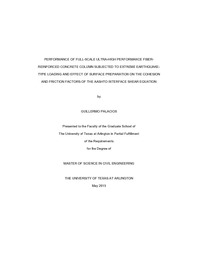
ATTENTION: The works hosted here are being migrated to a new repository that will consolidate resources, improve discoverability, and better show UTA's research impact on the global community. We will update authors as the migration progresses. Please see MavMatrix for more information.
Show simple item record
| dc.contributor.author | Palacios, Guillermo | en_US |
| dc.date.accessioned | 2015-07-31T22:10:15Z | |
| dc.date.available | 2015-07-31T22:10:15Z | |
| dc.date.submitted | January 2015 | en_US |
| dc.identifier.other | DISS-13134 | en_US |
| dc.identifier.uri | http://hdl.handle.net/10106/25082 | |
| dc.description.abstract | Buildings in areas of high seismicity may be subjected to large axial stresses as well as severe earthquake loading. In order to protect the integrity of these buildings, concrete columns must possess high compressive strength and adequate ductility. While the use of high strength concrete (HSC) may appear as an attractive alternative and can reduce the section size of first story columns, its increase in strength leads to an increase in brittleness compared to that of normal strength concrete. For that reason, HSC requires a large amount of transverse reinforcement to maintain adequate ductility, which leads to severe congestion in placement of the reinforcing bars and adds to the cost and effort. A solution may be found in ultra-high-performance fiber-reinforced concrete (UHP-FRC). UHP-FRC is an innovative material which provides high compressive strength (25-30 ksi) and shear strength as well as improved compressive ductility and excellent confinement characteristics. The addition of high strength steel microfibers into the high strength concrete mix can alleviate the need for excessive transverse reinforcement. The UHP-FRC mixture used in this research was created to maximize the dense particle packing concept, and it is nearly self-consolidating. Even though UHP-FRC provides superior material properties, there is limited test data available on its full-scale structural application. The performance of full-scale modern high-rise moment frame columns, with both normal strength concrete and UHP-FRC, tested under very large cyclic displacement reversals up to collapse is presented and discussed in the first part of this thesis. The use of UHP-FRC completely changes the typical failure mode of concrete columns as it improves confinement and prevents concrete crushing. Experimental results showed that the UHP-FRC column exhibited higher peak strength and greater drift capacity before succumbing to significant strength degradation compared to a conventional normal strength reinforced concrete column.The achievement of composite action of concrete bridge deck systems relies heavily on the bond between the precast beams and the cast-in-place concrete slabs. Two important components responsible for resisting horizontal shear are the cohesion and/or aggregate interlock, and the friction between the crack faces. The second part of this thesis investigates the influence of surface preparation on the cohesion and friction factors of the nominal interface shear resistance equation of the AASHTO LRFD Bridge Design Specifications (2012). A systematic surface preparation method was developed to recreate the different International Concrete Repair Institute (ICRI) Concrete Surface Profiles (CSPs) from which a series of push-off tests were performed to assess the contribution of the cohesion factor and the friction factor used in the AASHTO interface shear equation. An experimental program was developed made up of component push-off tests and full-scale composite box and slab beam tests. The experimental results suggest that the cohesion factor used by AASHTO may be considered un-conservative as both the cohesion factor and friction factor are not only dependent on the surface roughness, but also can be limited by the strength of the concrete matrix. The effect of a smoother surface finish typically formed with the use of SCC was also investigated in the full-scale specimens. | en_US |
| dc.description.sponsorship | Chao, Shih-Ho | en_US |
| dc.language.iso | en | en_US |
| dc.publisher | Civil & Environmental Engineering | en_US |
| dc.title | Performance Of Full-scale Ultra-high Performance Fiber-reinforced Concrete Column Subjected To Extreme Earthquake-type Loading And Effect Of Surface Preparation On The Cohesion And Friction Factors Of The AASHTO Interface Shear Equation | en_US |
| dc.type | M.S. | en_US |
| dc.contributor.committeeChair | Chao, Shih-Ho | en_US |
| dc.degree.department | Civil & Environmental Engineering | en_US |
| dc.degree.discipline | Civil & Environmental Engineering | en_US |
| dc.degree.grantor | University of Texas at Arlington | en_US |
| dc.degree.level | masters | en_US |
| dc.degree.name | M.S. | en_US |
Files in this item
- Name:
- Palacios_uta_2502M_13134.pdf
- Size:
- 89.50Mb
- Format:
- PDF
This item appears in the following Collection(s)
Show simple item record


